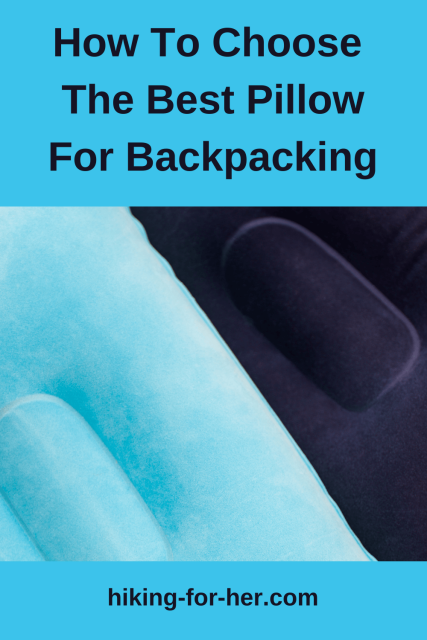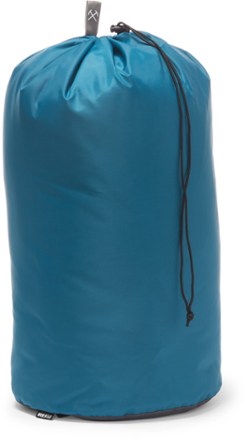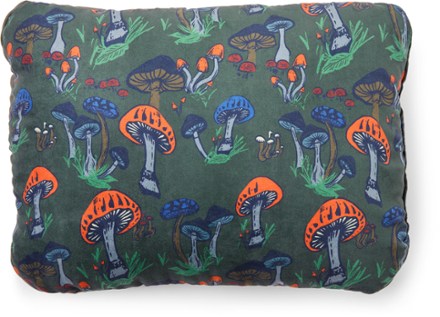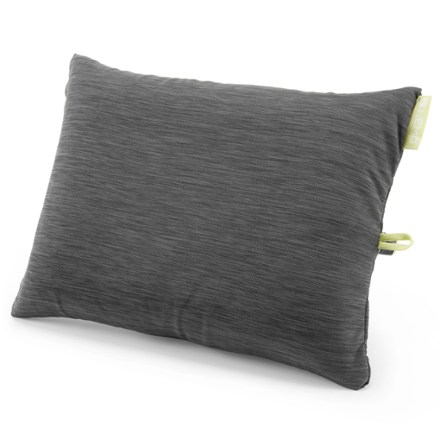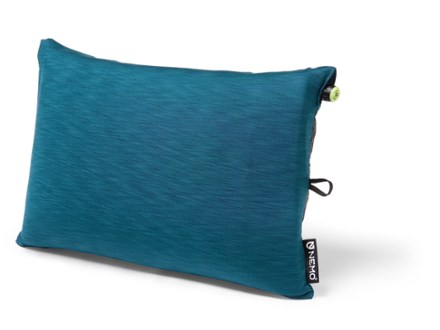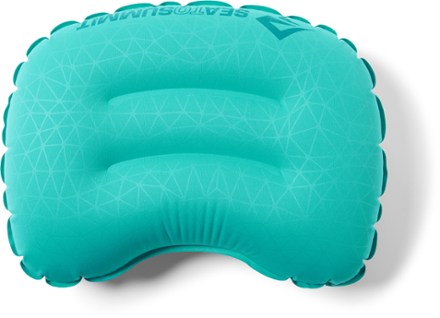
Backpacking Pillows:
How To Choose This Important Part
Of Your Sleep System
By Diane Spicer
Backpacking pillows: frivolous luxury, or essential hiking gear?
Either way, let's look at the benefits a backpacking pillow can give you after a long, tiring day on the trail.
Then we'll look at options for pillows that stand up to backpacking.
- Or skip down to the recommendation now.
- Some of these are affiliate links, meaning Hiking For Her earns a small percentage of your purchase price but it does not affect your cost.
Backpacking pillows:
the benefits of carrying one
The most important part of a restful night's sleep might be a pillow for you.
Even more important than staying warm and dry!
Here's why.
A pillow keeps your neck in alignment with the rest of your spine.
- Think about how sore your neck might be without the support provided by a pillow.
- Realize that your neck might feel sore from the exertions of backpacking to begin with.
Why aggravate that?
Need another reason to bring a pillow?
It acts as a cue to your body that says here is your soft nest for the night, just like your bed back home.
- Time to sleep, in other words. This makes falling asleep faster.
To test out these ideas, go for one night at home without a pillow.
In the cold light of the next morning, either add, or cross off, a backpacking pillow as part of your backpacking sleep system in your gear list.
One final reason to consider bringing a pillow backpacking: safety.
- If you're cranky, with a kink in your neck that won't go away, you won't be a safe navigator.
- Or a happy hiker.
Don't have a backpacking sleep system yet?
If you're just beginning to work out the intricacies of taking good care of yourself on a backpacking trip, you can read my extensive tips here:
Pay attention to these features
when you shop for backpacking pillows
We are going to keep these things in mind when shopping for the best backpacking pillows:
For the best chance of finding the perfect backpacking pillow, focus on two or three things on the list that are your top priority.
Or consider each of them in turn to maximize your options.
Let's get started on that list!
How much does the pillow weigh?
Weight is always a top priority for a backpacker, so make your pillow decisions with ounces in mind.
Coming in around 3 ounces is a good estimate, but again, if a pillow is important to you, go a little higher and shave off ounces somewhere else.
A trio of choices for backpacking pillows
There are three main ways to tackle the weight problem, based on the design of the pillow.
Your options, going lightest to heavier:
1. Inflatable backpacking pillows
2. Compressible pillows for backpacking
3. Some type of mix (hybrid) of the two
Inflatable pillows
use air, either your own or a through a valve (auto inflation). Air is
light, making these pillows the best choice for counting ounces.
Compressible backpacking pillows don't use freely available and lightweight air, so count on more weight from the material inside of them (foam, synthetics, feathers, or some combo).
Hybrid backpacking pillows play around with various iterations of inflation and compressibility. They will fall somewhere in the middle of the spectrum in terms of weight (and bulk, which is where we're headed next).
How big are backpacking pillows?
Please don't expect a backpacking pillow to be king sized.
Or even queen sized.
They're small. You're roughing it, remember?
What you're really asking is this:
How bulky is the footprint the pillow will create in your backpack?
If you're going ultralight with the smallest pack possible, it may surprise and dismay you to see how much space a rolled up, deflated pillow will hog for itself.
- If in doubt, run this little experiment at your local REI or other gear store.
And if space is at a premium in your backpack, don't even glance at compressible or (some) hybrid pillows, for fear of fainting.
- Again, return to your objectives before deciding to jettison the pillow from your gear list.
It all comes down to your safety and comfort.
If you prioritize a good night's sleep, and a pillow is part of that equation, make room for it!
Or take a serious look at stuffable pillows below, using your own compressible puffy jacket as filling.
Does the shape of a
backpacking pillow matter?
The answer may surprise you.
Yes!
A small pillow needs to be the right shape for your sleeping comfort.
Examples:
If you're a restless sleeper, prone to turning over a lot during the night, a square flat pillow might get flung into a tent corner.
- Look for contours that will "trap" you on the pillow. "Guide" might be a better word!
A rounded pillow might look good in theory, and if you tend to stay put once you fall asleep, you can expect that this pillow will do the job for you.
Side sleepers will enjoy a contoured pillow that can be snuggled into.
Some pillows, like the Klymit pillow below, are designed for keeping you squarely on the pillow no matter what kind of sleeper you may be.
Price points for backpacking pillows
A hiking gear budget can only go so far, so choose a pillow wisely and then splurge elsewhere on your gear list.
That means you need to go through this list of features very carefully.
Recommendation: Put a star next to your top 3 "must haves".
If price is among them, look only at pillows at low price points.They can be had for under $30 US, sometimes way under (stuffable and inflatable pillows).
Realize that some of your other important factors, durability and comfort for example, will be compromised.
So if there's wiggle room in your budget, look at higher price points in order to gain other features that can lead to a kink free neck in the morning.
Then go pillow shopping! (drop down to options here)
Comfort is key for most backpackers
Questions to ask yourself when choosing backpacking pillows:
- Is this pillow right for my preferred sleep position?
- How does it feel against skin?
- Will the contours hit my facial bones and neck just right?
- Does the pillow provide enough support and cushioning?
- Can I adjust the height of the pillow?
- What can I do to help the pillow trap my body heat and keep me from waking up at midnight?
- Am I backpacking in hot weather (I need breathability) or cold weather (insulation becomes important)?
To find the answers, you might have to borrow a few backpacking pillows, and give them a try during a nap or two.
Or read gear reviews ever so carefully.
Another consideration in the comfort category: how noisy is the pillow when your head is resting on it?
- In descending order of comfort, try compressible, hybrid, and then inflatable pillows if silence is golden in your book. Ear plugs, Plan B.
FYI: Some gear stores like REI allow you to "field test" the gear inside the store.
See if you can find a store that allows you to play around with pillows. Bring something clean to put over them while you test them out.
Trail tip:
Even when you've done your homework, you might find that a pillow that worked well on one backpacking trip just doesn't cut it on another.
Be prepared to hack around and find a fix by adding clothing beneath it for support, covering it with an extra shirt, or inflating it to a different degree.
If the pillow slides around on you, deploy some strips of Velcro glued to the pillow, and to whatever you want to anchor it to.
How easy is it to use and adjust the pillow?
You do have options for plumping up a pillow, as I just mentioned with inflatable and hybrid options, but the essential question is this:
- How hard is it to plump it up when you're tired and want to lie down and fall asleep RIGHT NOW?
If you also have to inflate your backpacking sleeping pad with your own breath, you might feel a little peeved to have to blow up your pillow before you can get some rest!
"Blow it up" might come to take on a new meaning ;)
So if this is a big concern for you, look at self inflating pillows, or compressible pillows that are good to go right out of your backpack.
How durable are backpacking pillows?
In other words: Will your investment pay off, season after season?
Maybe you don't care.
- If you're only doing one short trip on a lark, no worries: go for cheap and hope it won't deflate in the middle of the night.
- Or cram some clothes into your jacket, cram the wad into your sleeping bag, and call it good.
But as a thoughtful long term backpacker, always choose gear with durability in mind.
Your investment of time (in choosing wisely) and money (hard earned hiking budget) should pay off, season after season.
That attitude toward buying backpacking gear usually equates to paying more up front, and sticking with reliable brands with a good track record of customer ratings, favorable comments from other backpackers, and decent designs.
- More tips on how to buy good hiking gear here.
So you want a pillow covered in outer fabric like high quality nylon or thick materials that will stand up to abrasions, if durability is at the top of your "must have" list.
How do you keep your pillow clean
on a backpacking trip?
You'll be spending a lot of time drooling on that pillow (just me?).
And sometimes often your face and hair will be less than squeaky clean.
Is the outer surface of the pillow going to absorb skin oils and moisture as you sleep?
Can the pillow be cleaned with a quick wipe the next morning?
- Note to self: Look at Hiking For Her's hygiene tips to minimize the mess.
- Put together a backpacking hygiene kit, too.
So you already know the punchline:
To keep bacteria and grime from building up, it's important for a hygienic backpacker to choose a pillow that can be wiped clean.
Also consider how breathable the outer surface of the pillow is, which depends on the materials in it.
A pillow can make you feel sweaty (which accumulates on the surface), or keep you cool (less sweat, thus less grimy).
Some pillows, like the NEMO inflatable pillow below, come with their own snug little pillowcase that can be easily laundered, even on the trail.
Trail tip:
Down pillows are the hardest to keep clean on the trail, and will take more effort to clean up once you're home.
Backpacking pillows for sweet dreams
Now it's time to get real about selecting a pillow.
Allow me to show you a few good backpacking pillows.
We'll start with the most simple, inexpensive design: using a stuff sack plus your own clothing to create a pillow.
Stuffable pillows
If you're traveling light and have extra clothes (an outer layer like a puffy jacket that you don't wear for sleeping, for example), use a minimalist approach to cradling your head and neck:
- stuff a stuff sack.
NOTE: if all of your clothing is wet, will you want to stuff some of it into your pillow as one solid glob of dampness?
But in dry weather, it might make a great choice.
Trail tip:
Be sure to use a dedicated stuff sack, one that is free from food odors and can be kept with your sleep system, rather than pulling double duty on your gear list.
Ditto for a clean shirt you put over it to make the surface more inviting.
This is especially true in bear country.
Here's a good inexpensive choice, an REI Co-op Durable Stuff Sack with options for color and size:
Compressible pillows
Good news: These pillows may be as comfy as the ones on your bed at home.
Bad news: These pillows are bulky!
- Yes, they compress down to some fraction of their original size, but are not nearly as small in your backpack as an inflatable pillow.
They will also wrack up many more ounces than other pillow choices.
Trail tip: If you have a feather allergy, be sure to choose an inert synthetic filling like foam. Read the label carefully.
When comfort over weight, coziness over compressibility, are your choices, this puts you in the market for a compressible backpacking pillow.
Inflatable pillows
The main question to ponder: who is doing the inflating?
Good news:
Self inflating pillows are one less thing you have to deal with at the end of a long backpacking day.
While a pillow that needs a healthy dose of your own air is easier to adjust in terms of cushiony softness versus rock hard rigidity (according to your preferences).
Both of them will deflate easily and quickly into a small size.
Bad news:
Any inflatable pillow can go wonky. Now where is the duct tape for the slow leak you discovered last night? Oh, it's in your gear repair kit!
Or maybe you're just too tired to breathe into the darn thing at the end of a brutal trail day. Resentment does not make for good sleep.
Disclosure: An ultralight inflatable pillow is my personal preference as a side sleeper. Neck soreness seems to add up with the number of days on the trail, so I like being able to adjust the height and firmness.
- You can read my review of the Outdoor Vitals UL pillow here.
- Or see it here:

Here's another good choice for an inflatable backpacking pillow, starting out with the deluxe version for pillow connoisseurs:
When ounces truly matter AND you want to bring a pillow, look at this:
Restless sleeper? Who isn't after a few days on the trail!
Down backpacking pillows
Like to sleep with a down pillow? There are very few down backpacking pillows, but the one to take a look at is the Sierra Designs DriDown pillow.
Best backpacking pillows:
conclusions and a few notes
I've been on the trail for decades, and there are two things that I absolutely refuse to skimp on any longer:
- hiking nutrition
- an efficient, lightweight and comforting sleep system
You can read more about how I choose nourishing, satisfying backpacking food here.
And you've just read about how I put a lot of thought into choosing the best backpacking pillow for my sleep style and pack weight. Because it really matters to my well being on the trail!
Only you (and your sore neck) can decide which backpacking pillows works best for you, and don't be surprised if the answer changes over the years as your body does that thing called aging.
Maybe it has already?
- Tips for older hikers here.
A few more tips before we wrap this up:
Don't forget to bring along your backpacking pillow on car camping adventures.
Or toss it in a backyard hammock or picnic basket, or in the car (commuters, looking at you), for impromptu naps.
They also make a great spot for your small pet (no claws, please) to catch some Zzzzz's.
Get your money's worth!
Home page > Best Backpacking Tips >
Best Backpacking Pillow Choices
|
I get emails all the time about what I wear, eat, carry and love to use on the trail. That's
why I provide affiliate links to you: the best gear that I use myself and have seen used by other hikers is instantly
available for your consideration, and the gear company sends a few
pennies per dollar to this reader-supported hiking website. There is no added cost to you! Everyone ends up a winner: Great gear for you, strong gear companies, and more free hiking tips for everyone. Thanks very much for your support. It's warmly and sincerely appreciated. It also helps send these hiking tips to all your virtual trail buddies around the globe. |
 |
